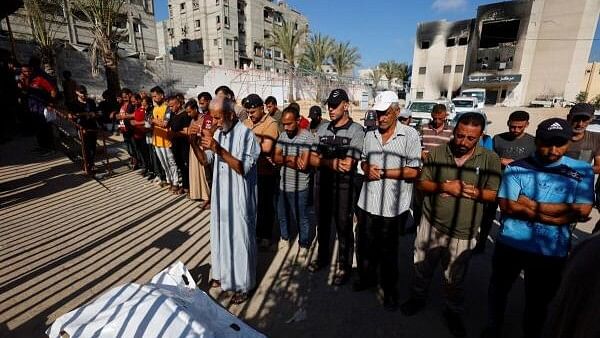
Mourners pray near a body of a Palestinian killed in Israeli strike, amid Israel-Hamas conflict, at Nasser hospital in Khan Younis in the southern Gaza Strip, August 13, 2024.
Credit: Reuters Photo
Beirut: In Gaza, the sky is full of menace. As well as the missiles that rain down on schools and shelters, the brutal rays of the sun have made the summer unbearable for those struggling to survive in a ravaged landscape of ruins and rubble.
Samaher al-Daour sometimes wishes she had been killed in the early days of the Israel-Hamas war rather than have to watch her son, who lost a leg during the conflict, endure the unbearable heat.
"The situation is horrible," said Daour, 42, as she sat beside her 20-year-old son Haitham in their sweltering tent in the southern city of Khan Younis in June.
"During the day, it is incredibly hot inside and outside the tent," she said in a telephone interview. "We go to the sea but it is still very difficult."
Haitham lost his leg in February during an Israeli airstrike on a school run by the United Nations Relief and Works Agency for Palestinian Refugees (UNWRA) in the Maghazi refugee camp in the central Gaza Strip.
Now the stifling heat is denying him the rest he needs to recover his strength. He sweats all the time and this is irritating his leg and making it swell.
"He is suffering because of this," said Daour.
After 10 months of war, almost all of Gaza's 2.3 million people are displaced. They live in tents or overcrowded shelters, and there is almost no electricity and little clean water.
Hungry and weak, they cannot shower and struggle to sleep in their boiling shelters. In the heat, food is rotting, drawing insects and flies to crowded camps where people, who have been forced to flee again and again, now risk heatstroke and other heat-related diseases.
Since April, Gaza has experienced several periods of extreme heat, with temperatures reaching around 40 degrees Celsius (104 degrees Fahrenheit) during that month. Temperatures throughout August reached an average high of 34 C (93 F), according to US private forecaster AccuWeather.
In late June, the World Health Organization said scorching heat could exacerbate health problems for the millions of displaced, warning that a public health crisis was looming due to the lack of clean water, food and medical supplies.
The heat is also making things more difficult for aid agencies, already hamstrung in their work by the airstrikes, fighting and ravaged infrastructure.
"It would be fair to say that the majority of humanitarian responders, including donors... have not really considered the threats of heat and extreme heat," said Paul Knox Clarke, principal at ADAPT, a climate and humanitarian initiative.
"The horrors" humanitarian organisations address in crises, he said, often take up too much bandwidth and prevent them from tackling additional challenges, like adapting to the effects of climate change during relief operations.
"It is not unprecedented, but it's not part of the normal playbook," he said.
"It has been complicating everything," said Prabu Selvam, medical officer for the Americares relief agency, adding that the transport of medicines that need to be kept cool was proving particularly challenging.
Because of Israeli restrictions, aid trucks often spend hours under the sun, waiting for clearance.
"Of course, it is going to impact the communities, because often the cold chain medicines are the ones that are most critically in need," Selvam said.
New challenge for aid agencies
Nearly 40,000 people have been killed and around 92,000 wounded since the Israeli army began its assault on Gaza, according to the Palestinian health ministry.
Israel launched its offensive after Hamas-led militants stormed into Israel on Oct. 7, killing around 1,200 people and taking around 250 hostages, according to Israeli figures.
The offensive has laid waste to homes, schools and vital infrastructure such as hospitals and clinics.
Israel has severely restricted the flow of food and aid into the Strip and humanitarian agencies have been warning of the risk of famine.
Now, the summer's extreme heat has added another layer to the suffering. Recent years have seen a series of lethal heatwaves strike the Mediterranean region and scientists say climate change is driving these dangerous heatwaves.
Save the Children is already adapting its operations in Gaza, said Fadi Dweik, a climate resilience expert at the charity.
Usually, the agency would focus on delivering mental health services and educational support as a first response, Dweik told the Thomson Reuters Foundation.
But now, it has prioritised delivering water and sanitation services and nutrition and health support.
"The conflict made us think of details and apply alternatives we had not thought of before," Dweik said. "For the first time the environmental factors are a priority because we cannot ignore them despite the war and destruction that exists."
The heat is not something Sabah Khames can ignore either.
The 62-year-old fled her home in Rafah close to the Egyptian border in May and now lives in a tent with 18 other relatives.
"The tent is a cramped caravan constructed entirely of sheet metal. It is like a sauna inside," she said in a phone interview.
"Sometimes, I can barely catch my breath."